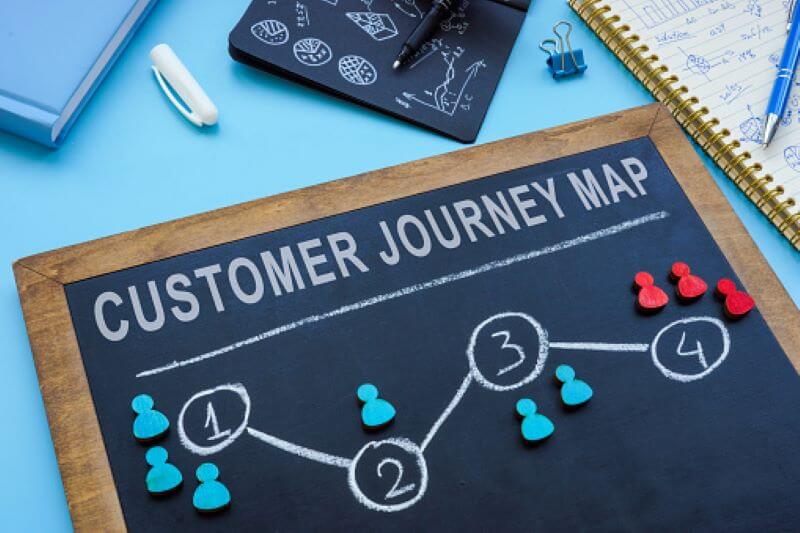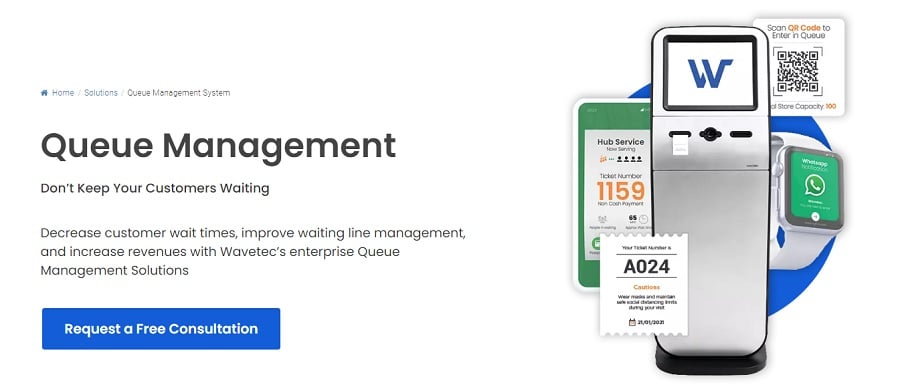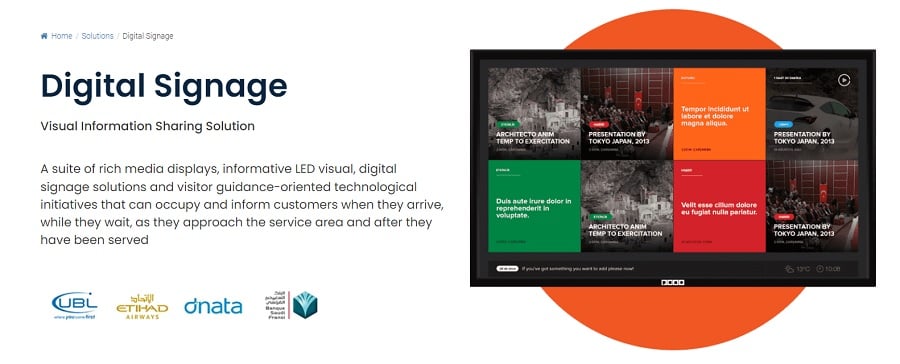Have you ever gone to a store during sale season, or to a bank, or to buy movie tickets, and found yourself stuck in a long line that refuses to move forward?
Or have you ever lost your way inside a hospital or government building and couldn’t finish your work in time? Well then, given your own experiences as a customer, you must realize how important customer experience is in running a business.
A smooth customer experience is key to ensuring the success of your business. This is because when customers are satisfied after interacting with your company, they are more likely to make repeat visits.
Overall customer satisfaction can result in positive feedback both online and by word-of-mouth. This in turn helps build the company’s reputation, increases the customer base, and ultimately, helps the business expand and earn more revenue.
In fact, a report published by the Tempkin group suggests that the revenue for companies that earn $1 billion annually can increase by 70% within 3 years if they work on developing a smooth customer experience.
A good customer experience is not only important for online businesses, online banking, and other online services but also in physical spaces such as government offices, retail stores, banks, and hospitals where customers go to seek various facilities. It is, therefore, extremely important for you to understand that whichever sector you plan on – or are already – operating in, customer experience must come first if you want to boost your growth.
In this guide, we will help you understand the importance of developing quality customer experience and provide you with some of the most effective strategies that you can apply to your business in any of the above-mentioned sectors.
What is Customer Experience?
Customer experience, also known as CX, refers to your customers’ overall view of your company after interacting with the services that it provides. This includes the online services offered by your business, such as your website, virtual assistance, and feedback tools, along with the physical services.
In the physical realm, some things that matter most to customers include their waiting time in a queue, how promptly your staff addresses their concerns, and whether or not they are able to navigate the site on their own.
If you are wondering how to boost the growth of an already existing business, you must put CX at high priority and allot time, effort, and money in ensuring that your customers are satisfied with their experience at your company. Good customer experience will help you build brand loyalty, increase your clientele, and, eventually, your revenue.
What is the Difference Between Customer Service and Customer Experience?
Many business owners tend to equate customer experience with customer service. While the two terms may seem interchangeable – and perhaps rightly so – they have different meanings.
Customer experience refers to the overall view your customers have of your brand after interacting with all the services it provides. It includes all the touchpoints in a customer’s journey from the point that they find out about your company to the point where they post a review online or file a complaint in case of a bad experience.
Customer service, on the other hand, is a component of customer experience and refers to customer interaction at each specific touchpoint within the entire journey. Some examples of customer service include virtual and physical assistance to respond to customer queries, refund and exchange policies, staff attitude towards the customer, etc.
If you wish to provide your customers with a good experience, one step that you will need to focus on will be the development of your customer service.
Why is Customer Experience Important For Business?
Why is it crucial for business? CX directly influences customer satisfaction, loyalty, and advocacy. A positive experience fosters lasting relationships, repeat business, and positive word-of-mouth. In a competitive market, prioritizing CX is not just good practice—it’s a strategic necessity for sustained success. Explore the depths of CX and understand why it’s the cornerstone of thriving businesses.
Reasons for Poor Customer Experience
Here are some of the common mistakes that hospitals, retail stores, banks, and government offices make that must be avoided at all costs if you wish to develop a good customer experience.
- Long queues on-sight
- Long wait/response times over call
- Customer queries left unanswered
- Employees’ Inability to Understand the Customers’ Needs
- Lack of Human Touch due to Excessive Reliance on Automation
- Service is not personalized
- Unprofessional Attitude of Employees Towards Customers
When it comes to customer experience, many businesses show neglect because they fail to recognize just how important it is to their success. Focusing on the quality and prices of products and services is not enough unless you put yourself in your customers’ shoes and understand their expectations from their interactions with your brand.
Let’s discuss in detail where businesses often go wrong.
1. Long Queues On-site
If you’ve ever tried shopping at the mall during the holiday season, tried to book a ticket for a new blockbuster or found yourself in a government building during rush hours, then you know how frustrating it is to wait in line with the work at hand getting delayed.
Long queues are why many customers turn back and decide to return later, visit another branch or switch to a new brand altogether. Having to wait in long lines is not only time-consuming but also slow and exhausting. It is both physically and mentally taxing for customers and disrupts their busy schedules. It is, therefore, necessary to manage queues and assure your customers that you value their time and effort, as well as the fact that they chose you to provide them with the product or service that they require.
2. Long Wait/Response Times Over Call
A recent study on customer experience reported that 20% out of the 2000 businesses that were a part of the survey believed that long wait/response times were the biggest cause of poor customer experience.
When customers interact with a business, they expect to get full support from the staff every time they have a complaint or want information, and if their expectations are not met, they develop a negative perception of your brand. If customers want to learn about the refund and exchange policy for your brand, for example, call to find out about it, and are made to stay on the line for ; long periods of time, they will get frustrated and will naturally have a bad experience.
3. Customer Queries Left Unanswered
The same survey also reported that around 18% of the 2000 businesses that were asked about customer experience believed that one of the major reasons why customers get frustrated is when their queries are left unanswered.
When customers interact with a business, there are many concerns that they have that they need clarity on before they proceed and if there is no assistance available to them or if they feel like their queries are being ignored, they develop a negative view of your company.
4. Employees’ Inability to Understand the Customers’ Needs
Employee training is key to ensuring that your customers’ needs are met in a timely and efficient manner. Around 18% of businesses believe that employees’ inability to meet customer needs is one of the biggest causes of poor customer experience.
Oftentimes employees are unable to make themselves available to customers as per their requirements and are unable to fulfill the duties that are expected of them. This makes customers feel like they are not being well catered to and ruins their experience.
5. Lack of Human Touch due to Excessive Reliance on Automation
Technology makes our lives vastly easy. From Self-service kiosks in restaurants to scanning discount codes or making transactions via credit cards, automation in every industry has allowed for faster operations, efficiency, and convenience. It is important to note, however, that for many customers, excessive automation can cause frustration. They may struggle to get the hang of the machinery and digital platforms or may simply feel more comfortable interacting with humans. It is the value that the human touch holds in the eyes of such customers that automation can cause poor customer experience.
6. Service is not Personalized
Another mistake that businesses tend to make is that they fail to make their service personalized for each customer. Customers expect the service that is provided to them to be tailored according to their specific needs. A customer in a shopping store. For example, would want the employee to show them clothes according to their requirements instead of showing them the general collection. Businesses that do not give each customer the attention that they need fail to deliver a good experience
7. Unprofessional Attitude of Employees Towards Customers
In their experience interacting with a service, customers often tend to remember the way they were treated by employees, and it is the very nature of this treatment that shapes their perception of the brand as well as their likelihood of developing loyalty towards it. Whether they are visiting a hospital, bank, or government office or shopping at the mall, customers like to be welcomed and treated kindly.
Employees that are rude towards their customers show their annoyance and frustration or get angry at them, making the customers feel like they are not being respected and, as a result, make them develop a negative overall perception of your brand.
What is customer experience management?
Customer Experience Management (CXM) is the practice of designing, overseeing, and optimizing all interactions a customer has with a business to enhance their satisfaction and loyalty. It involves a strategic approach to understanding and improving every aspect of the customer journey.
CXM includes various processes and technologies aimed at collecting and analyzing customer feedback, measuring satisfaction levels, and implementing changes to improve the overall customer experience. It goes beyond individual interactions to consider the entire lifecycle of a customer’s relationship with a brand.
Key components of Customer Experience Management may include customer feedback surveys, journey mapping, data analytics, personalization strategies, and the implementation of technology to streamline and enhance customer interactions.
Effectively managing customer experience is crucial for businesses aiming to differentiate themselves in the market, build strong customer relationships, and foster customer loyalty.
Understanding the Customer Journey

A customer journey refers to all the interactions that a customer makes with a brand, from the point that they feel the need for a certain product or service all the way up to the last touchpoint, which may be a complaint, a review, or a transaction. The customer journey covers all the steps of the interaction and all the touchpoints within those steps. It is the perception of the company that a customer has after going through the entire journey that defines their customer experience.
Customer journeys are important to understand your customers better by looking deeply into how they interact with your services at every stage. This in turn, provides you with insights that you can use to address their pain points and improve their experience.
Customer journey maps (CJMs) are the best way to visualize customer journeys.
Customer journey maps play a crucial role in helping businesses identify all the possible interactions within the journey, the possible flows that can be created out of these interactions, and customers’ pain points at every touchpoint. Pain points refer to the problems that people face along the customer journey.
Some common pain points that customers usually have throughout their journey include long queues, disrespectful employees, unaccommodating staff members, and the lack of a personalized experience. Analyzing these various pain points allows businesses to take measures to solve these issues.
Customer journey maps enable you to put yourself in the customer’s shoes and visualize their experience in detail. It gives you a different perspective and helps you understand their wants, needs, and expectations better. Viewing the experience from the customer’s lens also allows you to gain better insight into those steps of the journey that they are satisfied with and those that frustrate them.
Customer journey maps enable you to overcome the misconception that you are catering to your customer’s needs. You may realize when analyzing a pain point that the reason why your customer is not satisfied with your services is because of these unmet needs. For example, if you are running a fast-food restaurant and you have set up self-service kiosks for customers to place their orders, you may think that they will be 100% satisfied as they no longer have to stand in a line.
Despite taking this measure, you still end up receiving complaints. In such a case, if you draw up a customer journey map, you may find that long queues were never really an issue at your restaurant and that the main problem your customers face is at the cash counter where the employees take a long time to make your bill hence wasting their time.
Customer journey maps also allow you to understand that not all your customers will have the same journey and that some of them may skip a few touchpoints or take an entirely different route to reach the end. Let’s look at an example.
Say you run a clothing business that operates both in-store and online. The people who order from your website and those that prefer to come to visit the store are all your customers, and even though their starting point (the need or desire for new clothes) and ending point (wearing the clothes) are the same, their journeys are different.
Your online customer will first look for your website, then browse through your collection, add items to the cart, checkout, wait for the delivery, and then, once they have received the clothes, wear them. The journey could end here, but for some customers, it might go on if they have an issue with the size, for example. In that case, they will contact the brand for information on the exchange policy, order a new size, etc.
Your in-store customer, on the other hand, will physically visit your store, browse through the collection, try on the clothes, select what they want, get billing done at the cash counter, and take the items that they have bought a home. Here too, the touchpoints for each customer vary.
Essentially, what understanding the multiple possible customer journeys allows you to do is to focus separately on each specific touchpoint and try to address the pain points that your customers face.
Analyzing different customer journeys also enables you to understand which touchpoints are the most common amongst each customer so that you can prioritize them and work to make the CX their most efficient.
Moreover, it helps make customer experiences more personalized, which in turn develops brand loyalty and helps the business grow. It is, therefore, extremely important to spend time and effort in customer journey mapping because it is this effort that will enable you to go a long way.
What is a Good Customer Experience?

Good customer experience results from a business’s ability to understand its customers and address their pain points to ensure maximum satisfaction. A good customer experience means that a company values each customer, respects them and their time, promptly delivers responses to queries, and provides a platform for customers to leave their feedback.
Opening up the opportunity for customers to give you feedback and asking them questions about their experience throughout their journey can really help you see where you lack and improve your CX.
How to Deliver the Best Customer Experience? (3 Strategies for Maximum NPS)

1. Implementing Queue Management Solutions
Long waiting times can be a test of a customer’s patience. Waiting for a response from a company over the call or standing in long queues on-site causes a lot of frustration among customers. When customers come to purchase products or use the services in hospitals, banks, retail stores, etc., they have a task at hand that they need to get done, especially if they are on a tight schedule. Long queues cause chaos, crowd the space, and waste the customers’ time. Similarly, if they call a helpline to register a complaint or ask a question and are made to wait before the staff gets to them, they feel exasperated.

If you want to develop a good experience for your customers, you must understand that long queues are one the biggest reasons impacting their satisfaction because they begin to feel like their valuable time is getting wasted while they wait in line for their turn.
One of the ways to prevent long queues at cash counters and receptions in hospitals, government offices, and banks is by implementing digital and onsite customer queue management systems.
For example, hospitals and clinics can provide patients the option of booking appointments online so that they do not have to wait in line at the reception. Restaurants and banks can install self-service kiosks so customers can place orders themselves in the case of the former and print bank statements, request loans, make cash deposits, etc., on their own in the case of the latter.
Other queuing management solutions include digital signage and SMS, which can be very useful, especially in retail stores, as they help keep customers informed about potential waiting times, excessive foot traffic, opening and closing times, etc.
Other, more traditional solutions of managing queues include controlling the number of customers that enter a store at one time and setting up more cash counters and fitting rooms – in the case of clothing stores, for example – so that customers can be catered to quickly and efficiently.
Online feedback forms and virtual assistance through chatbots are efficient ways of reducing customer traffic over calls. Instead of staying on line for long periods of time, waiting for their queries to be answered and their complaints to be addressed, customers can use these facilities and save time.
Businesses can use one or a combination of queuing management solutions to improve their customer experience. Some of the biggest benefits of implementing queueing strategies are that they help customers save valuable time, address their issues in a timely manner, prevent chaos and large crowds, and ultimately increase customer satisfaction.
Despite the advantages of installing proper queuing systems, some challenges that businesses might have to face with this CX strategy are high initial investments, regular maintenance of the system, and access to expensive software.
2. Utilizing Digital Signage and Wayfinding Solutions
Have you ever gone to a hospital, bank, or government office and found yourself on the wrong floor, in the depths of the building, clueless about where to go?
Wayfinding is a common problem that customers face, especially when the place is big and they are visiting for the first time. In the circumstances like these, they need help finding directions, and if this help isn’t available to them, they end up being confused and frustrated, which ultimately impacts their perception of the company and shapes their decision to come again.

If you run a business that receives complaints from customers regarding the difficulty in navigating through your space, one of the best strategies to resolve the issue is by implementing wayfinding solutions and utilizing digital signage. These include LED displays, wayfinding kiosks, and mobile applications.
Video walls, projections, and screens using LED or LCD technology come under digital signage, which – as the name suggests – refers to signs and symbols that are digitally displayed to convey information to customers. Digital signage can be used as a wayfinding solution by displaying directions and floor plans so that customers can follow them and reach their desired destination.
Other wayfinding solutions include wayfinding kiosks and mobile applications. Wayfinding kiosks can be useful in places like malls and hospitals where the architecture is complicated, and customers and patients need to find their way. Mobile applications can also be developed for physical spaces and can use maps and GPS technology to help users locate where they are in the building and help them find their way around.
Wayfinding solutions like kiosks, mobile apps, and digital signage can be expensive to set up, and require high maintenance and access to complex software.
Moreover, they may be difficult to use for customers who are not accustomed to automation. However, these solutions also play a crucial role in developing better customer experience as they prevent customers from losing their way, help save valuable time, allow them to get their tasks done efficiently, and do not tax their physical and mental energy.
3. Gathering and Analyzing Customer Feedback
Customer feedback is a strategy for all businesses looking to improve their customer experience. Running a business and being able to retain your customers while also attracting new ones means that you need to center the whole experience around them.
You need to be able to put yourself in their shoes and understand what their needs and expectations are. In order to do this, you need to know what they think of your services and how they view your brand.
One of the best and most efficient ways to cater to customers and address their needs is by asking them to give you feedback. You must open yourself up to criticism instead of fearing what they might have to say.
It is only when you ask them the right questions and encourage them to give you their honest opinion on how their experience was through each touchpoint of the customer journey that you will be able to take the required measures to bring about change.
There are many ways that businesses can ask their customers for feedback. Many restaurants, for example, keep comment cards where customers can rate employee attitudes, food quality, ambiance, etc.
With the shift towards digital communications, many companies have also started making feedback forms available through their websites or mobile applications. This allows customers easy access to the form and enables them to write detailed responses about their personal experiences.
Social media applications like Instagram, Snapchat, and Facebook are also popular platforms for customers to review a certain brand. Businesses can also choose to post surveys on these platforms to get specific answers to CX-related questions.
Once businesses gather all the feedback that they have received, it is their job to analyze this data, identify the problems that customers face and then take action to address their concerns. Since data analysis is crucial in helping companies understand their customer’s pain points, they must hire qualified individuals to help them develop their customer experience.
One of the challenges that may come with gathering customer feedback, especially online, is that your reputation is put at stake. If someone posts a bad review about you online, for example, it involves the risk that the other people reading the review may get influenced by that particular opinion and develop a negative view of your brand. If matters worsen, a negative comment may be blown out of proportion, gain popularity and affect a wider group of potential clientele.
The benefits, however, of using this strategy far outweigh the disadvantages because they enable you to identify issues and understand your customers. Moreover, if you can address these issues, you can prevent these negative reviews and ultimately secure a good reputation.
Conclusion
Customer experience or CX is the overall view that customers have of a business or a brand after interacting with all of its services. A smooth customer experience is crucial to the success of any business, whether it is operating on a small or large scale.
This is because when customers are satisfied with your company, they are encouraged to make repeat visits, ultimately creating brand loyalty. They also give positive reviews online and talk about their experience with other people. This helps you establish a solid customer base, allowing for growth and increasing revenue.
Many people, even businesses themselves, tend to confuse customer service and customer experience. While customer experience is seen in terms of a customer’s overall perception of your brand, customer service refers to how they interact at each touchpoint. Customer service is a component of customer experience.
Businesses often tend to overlook the importance of developing good customer experience due to the misconception that the quality of their products and the prices that they set are the only things necessary to attract buyers and help them grow. Some of the most common mistakes these businesses make that lead to negative customer satisfaction include long waiting times on-site and on-call, rude employee behavior, lack of human touch, and the lack of personalized service.
Customer journey mapping is a helpful tool in helping businesses understand their customers’ needs and expectations better and in identifying their pain points. CJMs give detailed insights into the quality of interaction between the service and the customer at each touchpoint which in turn enables companies to address the issues customers may be facing and work to enhance their experience.
Depending on the insights gathered from customer journey maps, businesses can use multiple strategies to develop their CX. Three of the best strategies that can address common pain points include the implementation of queue management and wayfinding solutions, utilization of digital signage, and analyses of customer feedback.

